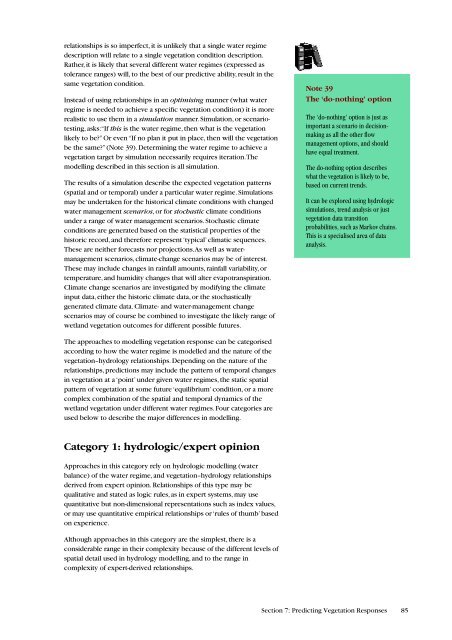Estimating the Water Requirements for Plants of Floodplain Wetlands
Estimating the Water Requirements for Plants of Floodplain Wetlands
Estimating the Water Requirements for Plants of Floodplain Wetlands
Create successful ePaper yourself
Turn your PDF publications into a flip-book with our unique Google optimized e-Paper software.
elationships is so imperfect, it is unlikely that a single water regimedescription will relate to a single vegetation condition description.Ra<strong>the</strong>r, it is likely that several different water regimes (expressed astolerance ranges) will, to <strong>the</strong> best <strong>of</strong> our predictive ability, result in <strong>the</strong>same vegetation condition.Instead <strong>of</strong> using relationships in an optimising manner (what waterregime is needed to achieve a specific vegetation condition) it is morerealistic to use <strong>the</strong>m in a simulation manner. Simulation, or scenariotesting,asks: “If this is <strong>the</strong> water regime, <strong>the</strong>n what is <strong>the</strong> vegetationlikely to be?” Or even “If no plan it put in place, <strong>the</strong>n will <strong>the</strong> vegetationbe <strong>the</strong> same?” (Note 39). Determining <strong>the</strong> water regime to achieve avegetation target by simulation necessarily requires iteration. Themodelling described in this section is all simulation.The results <strong>of</strong> a simulation describe <strong>the</strong> expected vegetation patterns(spatial and or temporal) under a particular water regime. Simulationsmay be undertaken <strong>for</strong> <strong>the</strong> historical climate conditions with changedwater management scenarios, or <strong>for</strong> stochastic climate conditionsunder a range <strong>of</strong> water management scenarios. Stochastic climateconditions are generated based on <strong>the</strong> statistical properties <strong>of</strong> <strong>the</strong>historic record, and <strong>the</strong>re<strong>for</strong>e represent ‘typical’ climatic sequences.These are nei<strong>the</strong>r <strong>for</strong>ecasts nor projections. As well as watermanagementscenarios, climate-change scenarios may be <strong>of</strong> interest.These may include changes in rainfall amounts, rainfall variability, ortemperature, and humidity changes that will alter evapotranspiration.Climate change scenarios are investigated by modifying <strong>the</strong> climateinput data, ei<strong>the</strong>r <strong>the</strong> historic climate data, or <strong>the</strong> stochasticallygenerated climate data. Climate- and water-management changescenarios may <strong>of</strong> course be combined to investigate <strong>the</strong> likely range <strong>of</strong>wetland vegetation outcomes <strong>for</strong> different possible futures.Note 39The ‘do-nothing’ optionThe ‘do-nothing’ option is just asimportant a scenario in decisionmakingas all <strong>the</strong> o<strong>the</strong>r flowmanagement options, and shouldhave equal treatment.The do-nothing option describeswhat <strong>the</strong> vegetation is likely to be,based on current trends.It can be explored using hydrologicsimulations, trend analysis or justvegetation data transitionprobabilities, such as Markov chains.This is a specialised area <strong>of</strong> dataanalysis.The approaches to modelling vegetation response can be categorisedaccording to how <strong>the</strong> water regime is modelled and <strong>the</strong> nature <strong>of</strong> <strong>the</strong>vegetation–hydrology relationships. Depending on <strong>the</strong> nature <strong>of</strong> <strong>the</strong>relationships, predictions may include <strong>the</strong> pattern <strong>of</strong> temporal changesin vegetation at a ‘point’ under given water regimes, <strong>the</strong> static spatialpattern <strong>of</strong> vegetation at some future ‘equilibrium’ condition, or a morecomplex combination <strong>of</strong> <strong>the</strong> spatial and temporal dynamics <strong>of</strong> <strong>the</strong>wetland vegetation under different water regimes. Four categories areused below to describe <strong>the</strong> major differences in modelling.Category 1: hydrologic/expert opinionApproaches in this category rely on hydrologic modelling (waterbalance) <strong>of</strong> <strong>the</strong> water regime, and vegetation–hydrology relationshipsderived from expert opinion. Relationships <strong>of</strong> this type may bequalitative and stated as logic rules, as in expert systems, may usequantitative but non-dimensional representations such as index values,or may use quantitative empirical relationships or ‘rules <strong>of</strong> thumb’ basedon experience.Although approaches in this category are <strong>the</strong> simplest, <strong>the</strong>re is aconsiderable range in <strong>the</strong>ir complexity because <strong>of</strong> <strong>the</strong> different levels <strong>of</strong>spatial detail used in hydrology modelling, and to <strong>the</strong> range incomplexity <strong>of</strong> expert-derived relationships.Section 7: Predicting Vegetation Responses 85
















